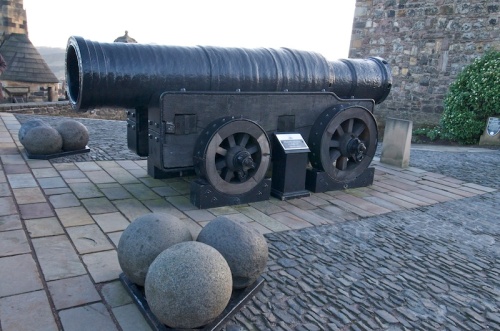Mons Meg, Medieval Bombard, Edinburgh, Scotland.
The Mongol armies that brought steppe warfare to its apex and overran most of Asia before conquering Russia in 1240 never penetrated the rest of Europe. But under the Mongol Empire (1226-1368), trade and travel across Asia intensified, and familiarity with gunpowder (as well as with printing and the compass) reached Europe from China, transmitted by anonymous artisans. The Chinese began to experiment with guns about 1290, but the earliest certain evidence of gun making dates from 1326 in Europe and 1332 in China, taking the form of two drawings of very similar vase-shaped vessels with an oversized arrow projecting from their mouths.
Long before gunpowder upset older ways of warfare, however, European knights suffered unexpected defeat at the hands of pike-carrying Italian foot soldiers in 1176; and when cities like Genoa began to manufacture powerful steel crossbows (initially used to defend ships at sea), knights lost their easy supremacy on land. Rival cities in northern Italy responded by pioneering the management of mercenary armies composed of crossbowmen, pikemen, and cavalry, while innumerable Italian artisans launched an arms race between ever stronger and nimbler crossbows and more perfect armor.
When gunpowder reached Europe, it had immediate and very drastic effects on warfare, whereas in China and other parts of Asia its effects were much less. That is not really surprising, since where cavalry warfare prevailed, early guns were useless for men on horseback; in China the government relied on walls to resist raiders from the steppes, and crossbows defended such walls more cheaply and far better than early guns could do.
But in Europe kings were interested in anything that could breach town and castle walls and allow them to assert their authority more firmly. Moreover, European artisans already knew how to cast church bells and speedily used the same skills for casting bigger and bigger guns. Not surprisingly, European guns quickly outstripped what Chinese and other Asian artisans produced-a lead that Europeans retained for centuries, at the cost of suffering increasingly destructive wars among a shifting array of growingly powerful states.
The Italians dropped out of the new arms race, which centered in the borderlands between France and Germany where French kings and German emperors competed for the best and newest guns. The speed was astonishing with which the toylike vase gun of 1326 was transmuted into clumsy bombards, about 3.5-4.5 meters (12-15 feet) long, like those that breached the walls of Constantinople in 1453. By 1477, they were replaced by mobile guns, about 2- to 2.5-meters (6-8 feet) long, permanently mounted on wheels yet capable of destroying city and castle walls in a few hours by shooting iron cannonballs.
Monarchs throughout Europe hastened to buy these weapons and used them to overawe rivals at home and expand their power to neighboring lands. Though dwarfed by the new style of armament, Italian city-states were not baffled for long by the power of the new siege guns. Instead, in 1500 the Florentines discovered almost by accident that loosely compacted earth could absorb cannon shot harmlessly, and by digging a vertical hole in front of earthen ramparts, attackers had to cross what amounted to an inverted wall in the face of defending guns. This so-called trace italienne put an effective obstacle in the path of Europe’s imperial unification of the kind that came to Russia, Turkey, India, and Japan when mobile siege guns like those of Europe reached those lands. But the new fortifications were expensive to construct, and thousands of guns defending (and attacking) them remained essential for enhancing royal power.
Further Reading Black, J. (2002). European warfare, 1494-1660. New York: Routledge. Cunliffe, B. (2008). Europe between the oceans: Themes and variations, 9000 bc-ad 1000. New Haven, CT: Yale University Press. France, J. (1999). Western warfare in the age of the Crusades. Ithaca, NY: Cornell University Press. Howard, M. (1976). War in European history. New York: Oxford University Press. Keegan, J. (1993). A history of warfare. New York: Knopf. McNeill, W. H. (1982). The pursuit of power: Technology, armed force and society since ad 1000. Chicago: University of Chicago Press. Neiberg, M. S. (2001). Warfare in world history. New York: Routledge. Parker, G. (Ed.). (1995).The Cambridge illustrated history of warfare: The triumph of the west (Rev. ed.). Cambridge, U. K.: Cambridge University Press. Wawro, G. (2000). Warfare and Society in Europe, 1792-1914. London: Routledge.
